Plant Season is Back
- MAIDO
- Apr 14, 2024
- 11 min read

Hello everyone. While Suzuki Farm's vegetables are available at Maido all year round, there is a kind of item that is very popular this time of year - seedlings. They started to be in stock at our store. We only have a limited varieties available now, but we plan to have more varieties in stock from now through May. (Each kind is available in limited quantities, so if there are particular types you are looking for, please contact us before coming in to the store.) We also have *True Leaf Market's Kitazawa Seeds vegetable seeds. There are only a few types left, so get them while they are still available.
We will introduce the seedlings, seeds, and vegetables themselves, and some recipes using some of them this week. We hope it will help you find the vegetables you want to grow/cook. Here we go!
*Suzuki Farm was established in 1983 in Delmar, Delaware. It is the only Japanese vegetable producer on the East Coast. Each season, a variety of Japanese vegetables grow in their 28 acre land. They harvest more than 30 kinds of vegetables throughout the year. They are one of the few farms owned by Japanese farmers in America.
**Since 1974, True Leaf Market has continued to earn the trust of home gardeners, professional growers and the seed industry by carefully curating premium brands including Kitazawa Seeds for Asian varieties.
***
Vegetable Seedlings Maido Offers
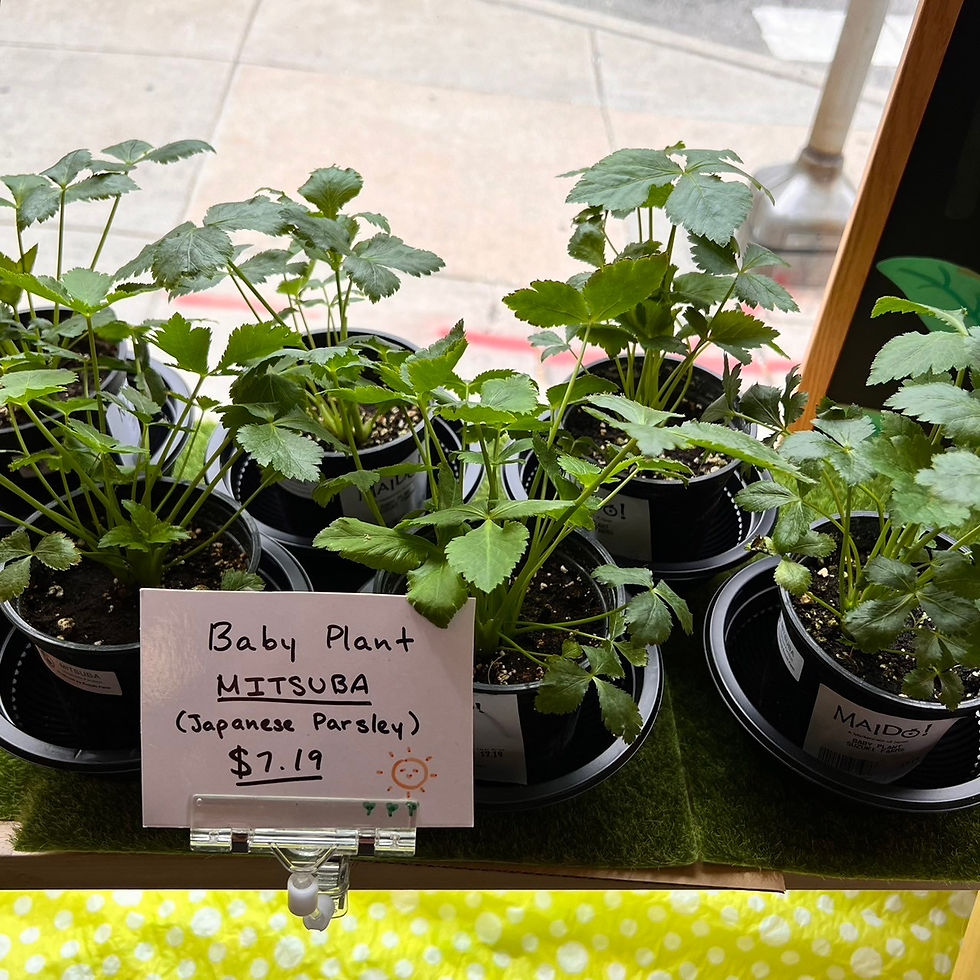

Mitsuba Leaves
Mitsuba is a member of the same family as parsley, and its leaves are used as herbs in Japan. Its name comes from its leaves, which are divided into three parts. Mitsu means three and ba means leaf/leaves in Japanese.
Mitsuba is a perennial herb. It grows 12” to 20” tall. The leaves are oval shaped and are narrow at the tip. The compound leaves are alternate and composed of three lobes. The leaf margins have double serrations. Flowering season is in summer, when the flower stalks extend to produce small white flowers consisting of five petals. After flowering, it produces oval fruits.
At Suzuki Farm, the crop is in season in spring, but is grown year-round because demand increases in winter. Therefore, they sow more seeds in early fall and grow them in greenhouses so that they can be shipped from the end of the year through March. The roots are harvested without cutting them and delivered to everyone in bunches.
With its bright green color and unique flavor, mitsuba is widely used in Japan by everyone from home cooks to professional chefs. Its versatility in a variety of dishes, from soups and salads to main dishes, makes it an attractive ingredient. Be sure to add them to miso soup, soup, and other dishes that are bright in both color and flavor. Not only will it look gorgeous, but it will also add a fresh spring flavor to the dish, making it sure to impress.
Whether you are a seasoned chef or just starting out in the kitchen, mitsuba is an essential herb for Japanese cuisine.
Recommended seedling temperature
Daytime: approx. 72°F/22°C
Night: approx. 59°F/15°C
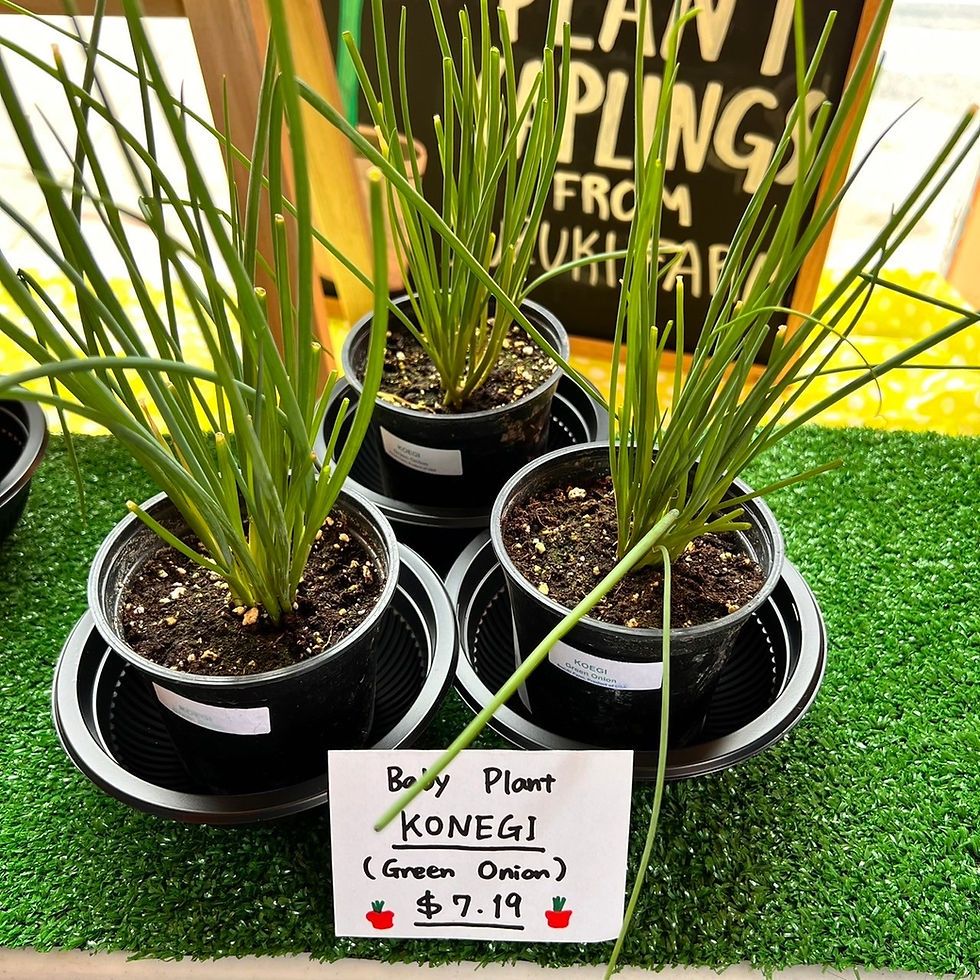

Konegi (Green onion)
Konegi is one of the varieties of green onion, a young green onion, growing to over 1'/30 cm. It is similar to the Tokyo negi leek, but much different in size, with the konegi being smaller, as the name shows. In Japanese, ko means small and negi means green onion. When transplanting, it is best to divide the plants and leave a space of 2"/5 cm between them to allow them to grow larger.
Did you know that konegi is not only tasty, but also healthy? This green and yellow vegetable is rich in carotene, vitamin C, calcium, and iron, which are ideal for maintaining healthy mucous membranes and strengthening the immune system. Plus, its antioxidant properties may help prevent colds and cancer. Incorporate the power of congee into your diet!
Konnegi is an indispensable seasoning in Japanese cuisine. When used as a topping, it makes dishes look much more professional and chef-like. If you are going to try your hand at home vegetable gardening, why not start with konegi, which are easy to grow and have a short growing season. You will surely want to try growing other types after that.
Recommended seedling temperature
Approx. 64°F/18°C


Peaman Bell Pepper
As most of you know it already, there are many varieties of peppers, including bell peppers and chili peppers of various colors, which can be found in most grocery stores. peman is a unique variety that is harvested while still green and unripe, removing the pungency found in other peppers and leaving a distinct bitterness and aroma. The size of peman is much smaller than bell peppers you usually see at the stores in America.
Japanese children tend to dislike peman because of their strong pungency, so a lot of parents chop them and secretly put them in the dishes. However, this dark green vegetable is surprisingly rich in vitamins, which help prevent heat exhaustion, increase energy, and improve blood circulation. Adding peman to your diet can help keep your blood vessels clean and blood thin.
Peman are harvested when they are relatively young, about 40 days after flowering. It can be used in a variety of dishes, such as stir-fried with shredded beef or stuffed peman. Suzuki Farm grows peman from June to October, and now is the time you can get the seedlings.
Recommended seedling temperature
Daytime: approx. 82°F/28°C
Night: approx. 64°F/18°C
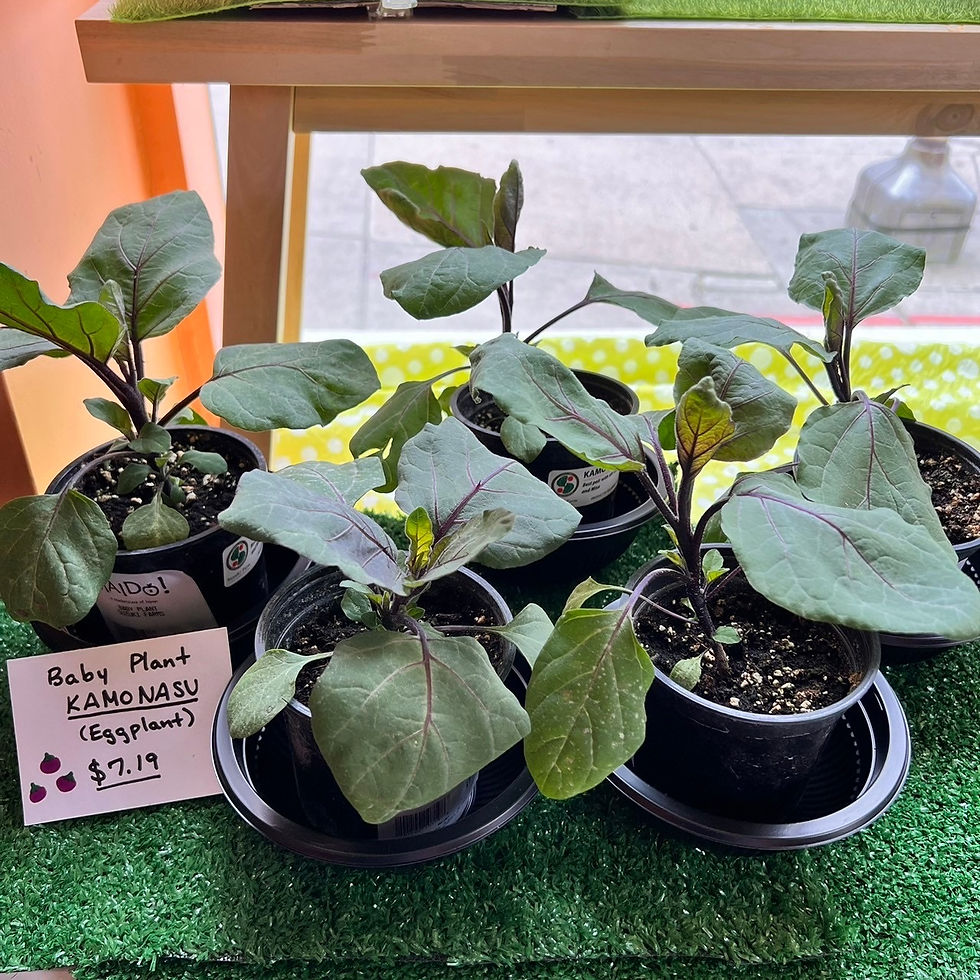

Kamo Nasu Eggplant
Kamo nasu eggplant is a traditional Kyoto vegetable grown in Japan's historic old capital, Kyoto. It is a popular eggplant that brightens the summer table in Kyoto. It is characterized by its velvety skin, dense, round, and relatively large size, and is called the queen of eggplants in Japan for its stately appearance.
It is ideal for deep frying, absorbing little oil, and their dense flesh retains its firmness even after cooking. They are thick, filling, and creamy. Dengaku is a typical dish of Kamo nasu eggplant. It is a classic Japanese side dish made with the eggplant sliced in half, scored and brushed with a sweet and savory miso sauce. It is a very popular dish because of the exquisite harmony of eggplant and miso.
Suzuki Farm harvests Kamo nasu eggplant from June to September as well as regular eggplant. We encourage you to grow, harvest, and cook with this variety, which is loved by many top chefs.
Recommended seedling temperature
Daytime: approx. 82°F/28°C
Night: approx. 62°F/17°C
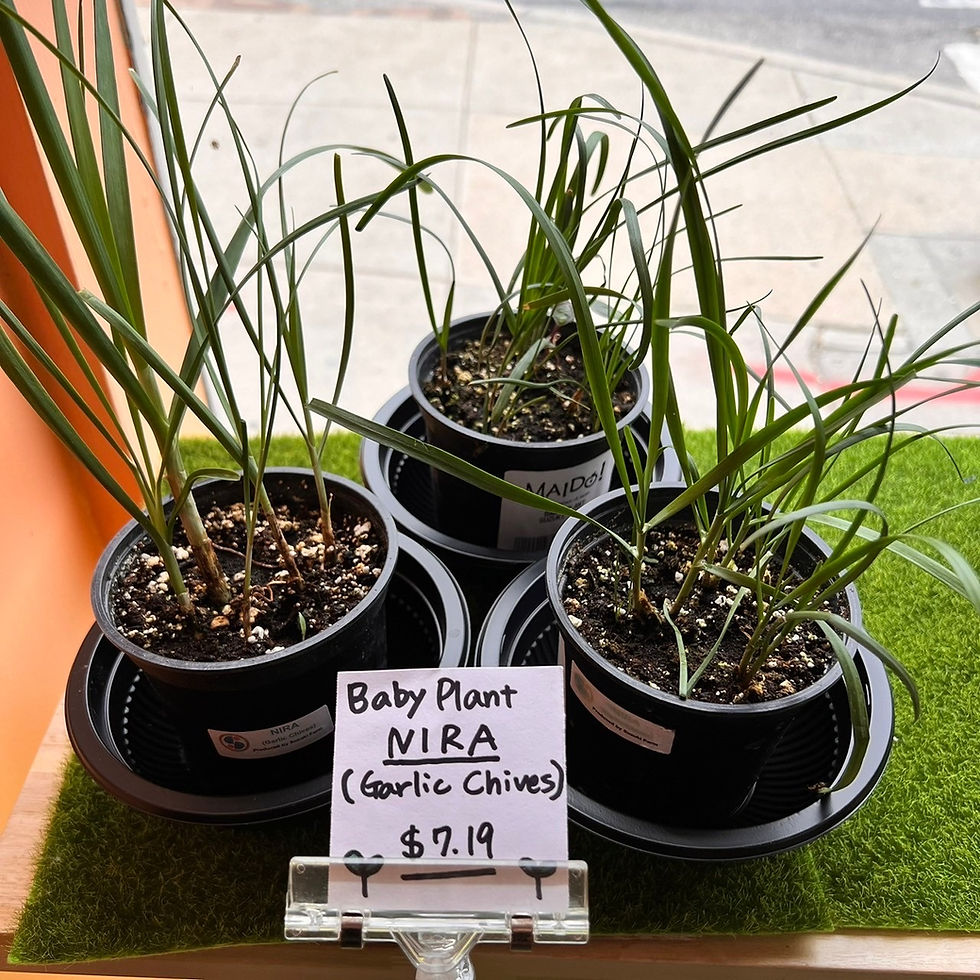

Nira Garlic Chive
Nira, also called garlic chive, is a popular vegetable in East Asia. Nira is in season from spring to early summer. It is rich in vitamins and minerals, which helps prevent swelling, improve bowel movements, and aid in the metabolism of carbohydrates and iron. In addition, nira contains allicin, which gives them a distinctive aroma similar to garlic. Allicin is known to relieve fatigue and reduce elevated blood sugar levels. Allicin is absorbed more efficiently when combined with vitamin B1, which is found in pork and grains. For this reason, many people recommend cooking nira with pork.
There are many delicious ways to eat it, including stir-fries, dumplings, soups, egg dishes, and rice porridge. To fully appreciate the sweetness and umami of nira, heat it as little as possible; overcooking will damage its color and flavor.
To grow nira, choose a sunny, well-drained location for sowing or transplanting. Water frequently after sowing. After germination, thin the plants to increase the space in between. It has a strong life force, and new leaves will grow even after being cut. Therefore, it can be harvested several times a year.
At Suzuki Farm, only the green leaves of nira are grown and harvested. Nutritious and resistant to heat, this is one of the few vegetables that can be harvested in midsummer, and we hope you will grow, cook, and enjoy it yourself this summer!
Recommended seedling temperature
Daytime: approx. 77°F/25°C
Night: approx. 59°F/15°C
***
Vegetable Seeds Maido Offers

Radish Raphanus Sativus - Tokinashi All Season
50 to 60 Days to maturity. Cool Season Annual. Tokinashi All Season radishes are very popular in Japan and other Asian regions for their flavor and versatility. As its name implies, this variety can be grown year-round in some climates! They are slow to bolt so they can handle some heat. The roots will grow 10 to 16" long and 2" in diameter with a point like a carrot. Tokinashi radishes will always turn out high-quality, tasty, and beautifully white.
Tokinashi All Season radishes can be planted either after the last spring frost or in the late summer and early fall. Loosen the soil before planting to give the roots space to grow. Sow seeds 1/2" deep in rows 12" apart. Plants should be thinned to 3" shortly after germination. Water and fertilize as needed, but avoid high nitrogen fertilizers.
Daikon radishes are easy to harvest. Simply pull the radishes out of the soil by grasping the base of the plant. If your soil is very compacted, you may need to use a shovel or gardening fork to loosen the soil. They store very well in the fridge! Simply cut off the tops and store them in your vegetable drawer for up to a month. Store the tops in the fridge as well.
They are often used to make spicy, pungent sauces for sashimi or tempura, as well as being simmered in Japanese stew, hot pot etc. You can also use them as a garnish to add a bright kick to any dish! Try slicing them thinly and adding to a salad.
Do not forget that a lot of variables can affect radish flavor when growing them. Heat waves, inconsistent moisture, and waiting too long to harvest can all make your radishes more spicy and bitter. Keep these in mind as you grow your radishes!

Radish Raphanus Sativus - Korean - Bora King - Hybrid
60 days to maturity. Cool season annual. Bora King radishes live up to their royal name by being a gorgeous purple all the way through! Its bright green tops contrast beautifully with the roots, and they are both edible and delicious. Slow to bolt and easy to grow, Bora King radishes are a truly unique variety that you will not regret trying. Buy some today and wow your friends with some delicious, visually stunning dishes this fall.
Choose a location in your garden with full sun and good drainage. Sow seeds in bands 18 to 24 inches apart, and thin seedlings four to six inches apart once they have grown. Keep consistently moist. Fertilize as needed.
After about 60 days or when radishes begin to show their shoulders above the soil, harvest them by gripping the base firmly and pulling straight upwards. If the radishes are difficult to pull, try loosening the soil around the plants with a shovel. Try to avoid ripping the leaves, because they are also edible! If you struggle with this, try cutting the leaves at the base to harvest, and then dig up the radishes separately.
There are so many great uses for Bora King radishes! Try pickling them to make a delicious garnish for soups or salads. Slice and eat fresh, or find traditional Korean recipes online. If you like spicy food, try musaengchae! It is a radish salad that makes a great side.
If you want your radishes to grow big, colorful, and tasty, follow these 3 simple tips! Loosen the soil before you plant, water consistently, and feed your plants. This will give them the space and resources they need to live up to their full potential.

Soybean Glycine Max - Chiba Green
78 days maturity. Glycine max 'Chiba Green'. Chiba Green Soybean Seeds. Heirloom, Non-GMO. Warm season annual. Open pollinated. These high-protein and nutritious legumes are used throughout Asia as a staple food source. Chiba Green is known for its green seed coat and large seeds. This variety produces large pods with many containing three seeds. It is a medium maturing type. Chiba was adapted throughout the USA, it also performs agreeably in numerous foreign countries. Due to its high yield-to-space ratio, it is an excellent choice for many gardening styles.
Sowing too early in the season might induce thick plant growth and decrease yield; it is best to seed in the early summer. Warm day temperatures and cool night temperatures are vital for good results. The seeds will rot or not germinate altogether if overwatered. Keep soil moist but not soaked before they sprout.
After sprouting, allow for the soil to dry between waterings. Fertilize as needed when the plant appears pale; avoid high nitrogen content. Soybeans prefer a temperate climate and have no frost tolerance. These plants do not typically need extra supports. In cooler climates, soybeans do well under frames, unheated greenhouses, or cloches.
Harvest when soybeans swell in the pods and the leaves have changed from bright green to slight yellowish-green. These are perfect for eating promptly. Another option is to harvest 25-30 days later for the dry beans. To get dry beans, wait for the plant to turn brown then completely dry it by hanging the plants upside down. After harvest, leave the roots in the ground to decay and release their nitrogen content to enrich the soil with nitrogen for other crops.
The young green pods are delightful steamed, boiled, or stir-fried. Blanch the fresh beans and then freeze them to store your extra harvest for a winter treat. Prepare edamame, part of traditional Japanese fare, by boiling fresh pods for 3-4 minutes in salted water. Serve them as a healthy appetizer or snack. The dry beans can be made into flour, soy milk, or soaked and boiled into soups.
You can pop edamame beans out of their pods, dip them in salt, and eat them happily. Such a fun treat!
***
Vegetables Maido Offers
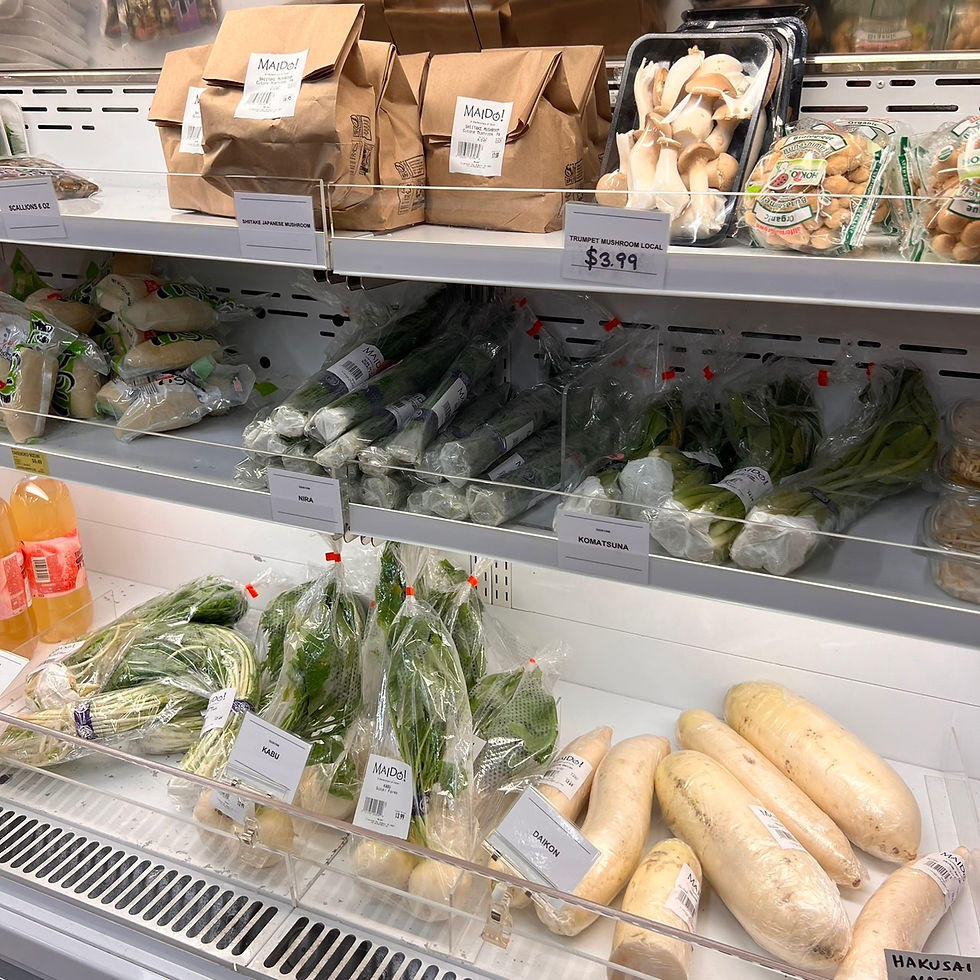

Kabu Turnips
You are probably familiar with daikon radishes, but have you ever seen these small, round, white turnips? Not only are these kabu turnips plump and lovely, they are also surprisingly tasty. The white-skinned variety called ko-kabu, which literately means small turnips are famous as a typical early spring vegetable in Japan.
How do you eat them? Whether in miso soup or as asazuke lightly pickled kabu, this white fruit and its green leaves are not only nutritious but also enhance any dish. For those looking for kabu turnip recipes, stewed kabu turnip and ground pork with starchy sauce is highly recommended.
Suzuki Farm grows turnips mainly in the fall and spring. To ensure a good harvest in the winter, the seeds are sown in the fall when the weather is favorable and grown slowly outdoors in the cold. However, even the slightest delay in sowing the seeds will hinder their growth. Let's be thankful to Suzuki Farm for delivering the best kabu turnips throughout the year and enjoy their delicious taste.

Green Shiso/Ohba Leaves
Green shiso belongs to the shiso family and is probably the best-known herb in Japan, and is an essential ingredient in Japanese cuisine. Fresh shiso leaves are often used as a condiment to savor its unique aroma in sushi, as well as in salads, stir-fries, and deep-fried dishes. Green shiso tempura is also surprisingly tasty! The plant or seedling is called shiso (green shiso is called aojiso, and red shiso is called akajiso), but the product itself is often called ohba, and even at Maido, green shiso is sold as ohba.
Shiso leaves have a well-known refreshing aroma due to an essential oil component called perillaldehyde. They are also believed to stimulate appetite, metabolism, perspiration, and antiseptic properties. For this reason, sushi chefs use green shiso not only for their color and aroma, but also as a preservative.
Although shiso leaves tend to spoil quickly, their shelf life can be extended by wrapping them in a damp paper towel and storing them in a plastic bag. To further prolong freshness, wrap each leaf individually. Alternatively, shiso leaves can be lightly wetted, placed in a plastic bag, and stored in the vegetable compartment of a refrigerator.
Suzuki Farm grows green shiso all year round in greenhouses, so we sell them all year around at Maido. In summer, the greenhouse is kept in semi-shade to prevent the young leaves from hardening in the strong sunlight. In winter, on the other hand, we use gas heaters to control the temperature. What kind of dish would you like to try with this herb?
***
There is a lot of food items, housewares, stationery, and gifts available at the store and our online store, Maido! Kairashi Shop, where you can place your order for shipping or store pickup! Happy shopping. :)




Comments